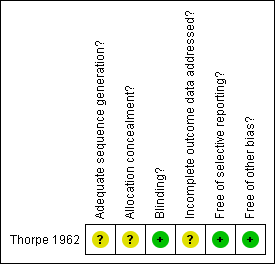Incentivos económicos para la esquizofrenia
Referencias
Referencias de los estudios incluidos en esta revisión
Referencias de los estudios excluidos de esta revisión
Referencias adicionales
Characteristics of studies
Characteristics of included studies [ordered by study ID]
Ir a:
| Methods | Allocation: randomised, no further details. | |
| Participants | Diagnosis: schizophrenia (Arieti 1955 2nd or 3rd stage). | |
| Interventions | 1. Monetary reward: One hour session in the morning assembling plastic dolls, task required considerable manual dexterity, inserting two arms and two legs into appropriate sockets of doll's body. Session repeated for an hour in the afternoon. Paid 3 pence/12 dolls assembled. N=10. 2. No monetary reward: Same work assembling dolls with no monetary reward. N=15. | |
| Outcomes | Target behaviour: average number of dolls produced per day.** | |
| Notes | * Only data from first two week arm of trial used as data after first cross‐over prone to bias. | |
| Risk of bias | ||
| Bias | Authors' judgement | Support for judgement |
| Adequate sequence generation? | Unclear risk | No description: "the twenty‐five patients were split into five groups of five by a random‐selection technique". |
| Allocation concealment? | Unclear risk | No description: "these groups were numbered one to five and patients within each group worked together in a small circle". |
| Blinding? | Low risk | Not practical to blind participants to treatment, unclear if raters blind to allocation: "patients in groups 1 and 4 were informed that they would be working for money and paid according to how many dolls they were able to assemble as a group. Patients in groups 1,2, and 5 were informed that they would be assembling dolls but would not receive any payment". |
| Incomplete outcome data addressed? | Unclear risk | No description. |
| Free of selective reporting? | Low risk | All outcomes reported. |
| Free of other bias? | Low risk | No description of author affiliations given, but thought other biases unlikely. |
Characteristics of excluded studies [ordered by study ID]
Ir a:
| Study | Reason for exclusion |
| Allocation: unclear. | |
| Allocation: random. | |
| Allocation: random. | |
| Allocation: random. | |
| Allocation: random. | |
| Allocation: random. | |
| Allocation: random. | |
| Allocation: random. | |
| Allocation: random. |
Data and analyses
| Outcome or subgroup title | No. of studies | No. of participants | Statistical method | Effect size |
| 1 Target behaviour: average number of dolls assembled per day Show forest plot | 1 | 25 | Mean Difference (IV, Fixed, 95% CI) | ‐0.80 [‐1.41, ‐0.19] |
| Analysis 1.1  Comparison 1 MONETARY REWARD vs NO MONETARY REWARD, Outcome 1 Target behaviour: average number of dolls assembled per day. | ||||
| 2 Leaving the study early Show forest plot | 1 | 25 | Risk Difference (M‐H, Fixed, 95% CI) | 0.0 [‐0.15, 0.15] |
| Analysis 1.2  Comparison 1 MONETARY REWARD vs NO MONETARY REWARD, Outcome 2 Leaving the study early. | ||||

Methodological quality summary: review authors' judgements about each methodological quality item for each included study.

Comparison 1 MONETARY REWARD vs NO MONETARY REWARD, Outcome 1 Target behaviour: average number of dolls assembled per day.

Comparison 1 MONETARY REWARD vs NO MONETARY REWARD, Outcome 2 Leaving the study early.
| Methods | Allocation: randomised, clearly described. |
| Participants | Diagnosis: schizophrenia. |
| Interventions | 1. Additional funds: not given every day but intermittently and randomly*** as reward for countering person‐specific negative symptom. N=150. 2. No additional funds. N=150. |
| Outcomes | Target symptoms: improved/not improved to important extent. |
| Notes | * in suggesting cross‐over design we are attempting to ensure that everyone is assured of reward. |
| Monetary reward compared with no monetary reward for schizophrenia | ||||||
| Patient or population: patients with schizophrenia1 | ||||||
| Outcomes | Illustrative comparative risks* (95% CI) | Relative effect | No of Participants | Quality of the evidence | Comments | |
| Assumed risk | Corresponding risk | |||||
| no monetary reward | Monetary reward | |||||
| Target behaviour: average number of dolls assembled per day | The mean Target behaviour: average number of dolls assembled per day in the intervention groups was | 25 | ⊕⊝⊝⊝ | |||
| *The basis for the assumed risk (e.g. the median control group risk across studies) is provided in footnotes. The corresponding risk (and its 95% confidence interval) is based on the assumed risk in the comparison group and the relative effect of the intervention (and its 95% CI). | ||||||
| GRADE Working Group grades of evidence | ||||||
| 1 Very chronically ill, not actively psychotic | ||||||
| Outcome or subgroup title | No. of studies | No. of participants | Statistical method | Effect size |
| 1 Target behaviour: average number of dolls assembled per day Show forest plot | 1 | 25 | Mean Difference (IV, Fixed, 95% CI) | ‐0.80 [‐1.41, ‐0.19] |
| 2 Leaving the study early Show forest plot | 1 | 25 | Risk Difference (M‐H, Fixed, 95% CI) | 0.0 [‐0.15, 0.15] |

